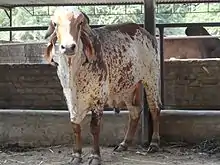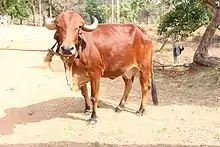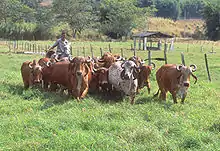Gyr cattle
The Gir or Gyr is one of the principal Zebu breeds originating in India. It has been used locally in the improvement of other breeds including the Red Sindhi and the Sahiwal. It was also one of the breeds used in the development of the Brahman breed in North America. In Brazil and other South American countries the Gir is used frequently because, as a Bos indicus breed, it is resistant to hot temperatures and tropical diseases. It is well known for its milk producing qualities and is often bred with Friesian cows to make the Girolando breed.
 Bull at Bhavnagar | |
| Conservation status | FAO (2007): not at risk[1]:144 |
|---|---|
| Other names |
|
| Country of origin | India |
| Distribution |
|
| Use | dairy |
| |


The Gir is distinctive in appearance, typically having a rounded and domed forehead (being the only ultraconvex breed in the world), long pendulous ears and horns which spiral out and back. Gir are generally mottled with the colour ranging from red through yellow to white, black being the only unacceptable colour. They originated in southwest India in the state of Gujarat and have since spread to neighbouring Maharashtra and Rajasthan.
Cows average 385 kg in weight and 130 cm in height; bulls weigh 545 kg on average, with a height of 140 cm.[3] At birth, calves weigh about 20 kg.[3] The average milk yield for the Gir is 1590 kg per lactation, with a record production of 3182 kg at 4.5% fat in India. In Brazil they average 3500 kg per lactation, with a world record production of 17 120 kg by the cow Profana de Brasília.
In 2003 the Gir numbered about 915 000, or 37% of the 2.5 million cattle population of the Saurashtra region of Gujarat.[4] In 2010 the population in Brazil was estimated at approximately five million.[5]
See also
References
| Wikimedia Commons has media related to Gir (cattle). |
- Barbara Rischkowsky, D. Pilling (eds.) (2007). List of breeds documented in the Global Databank for Animal Genetic Resources, annex to The State of the World's Animal Genetic Resources for Food and Agriculture. Rome: Food and Agriculture Organization of the United Nations. ISBN 9789251057629. Accessed January 2017.
- Valerie Porter, Lawrence Alderson, Stephen J.G. Hall, D. Phillip Sponenberg (2016). Mason's World Encyclopedia of Livestock Breeds and Breeding (sixth edition). Wallingford: CABI. ISBN 9781780647944.
- Marleen Felius (1995). Cattle Breeds: An Encyclopedia. Doetinchem, Netherlands: Misset. ISBN 9789054390176.
- G.K. Gaur, S.N. Kaushik, R.C. Garg (April 2003). The Gir cattle breed of India - characteristics and present status. Animal Genetic Resources/Resources génétiques animales/Recursos genéticos animales 33: 21–29. Rome: Food and Agriculture Organization of the United Nations. doi:10.1017/S1014233900001607. Archived 21 April 2019.
- Vijaysinh Parmar (27 September 2010). Holy cow! Gir gai goes global via Brazil. Times of India: Rajkot News. Accessed April 2019.